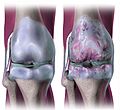User:WWCWRMT/sandbox
Heading text
[edit | edit source]This is an analysis of “Joint Injury in Young Adults and Risk for Subsequent Knee and Hip Osteoarthritis” by Gelber et al (2000).[1]
What is the Background to this Research?
[edit | edit source]Osteoarthritis is a significant health issue worldwide and is a major cause of morbidity, disability and pain. Research of youth sporting injuries and an increased risk of developing osteoarthritis in older age may assist to develop and evaluate interventions for prevention. Osteoarthritis is a degenerative condition that effects the loading bearing joints of the hip, knee and ankle, and also the hands and spine. It can involve the damage and loss of cartilage, remodelling of bone, osteophyte formation, weakened ligaments and muscles and synovial inflammation. It is the most common form of arthritis in Australia with an increase in prevalence with older adults. Osteoarthritis is the leading cause of hip and knee replacement. [2][3][4][5][6] Primary symptoms are joint pain, stiffness and movement limitations. Initially the joint pain is during and after activity increasing to with negligible movement and when resting, with joint failure and disability.[2][5]
Where is the Research from?
[edit | edit source]The study was undertaken at the Johns Hopkins University School of Medicine in Baltimore, Maryland. The article was published in the journal the Annals of Internal Medicine, which is a peer reviewed medical journal. [1]
What kind of Research was this?
[edit | edit source]This study was a prospective cohort study conducted over 47 years. The objective was to examine the relationship between joint injury and the incident of knee and hip osteoarthritis. [1] A prospective cohort study is the observation of a group of similar individuals and followed prospectively over a time period to observe the outcome of a condition in relation to a suspected risk factor. According to the Levels-of-Evidence rating, the study of Joint Injury in Young Adults and Risk for Subsequent Knee and Osteoarthritis [1] is catergorised as a level II, which demonstrates a valid and substantial study.[7]
What did the Research involve?
[edit | edit source]The research involved 1337 medical students of the graduating class of 1948 to 1964 at the Johns Hopkins University of Medicine. At entry to the study participants underwent a standard history and examination, including assessment of history of trauma, musculoskeletal disorders, physical activity, weight and height and body mass index. Injury was defined as trauma to the knee or hip joint, including internal damage and fracture. They were followed prospectively with annual self-administered questionnaires till 1995. A median follow up of 36 years. [1]
What were the Basic Results?
[edit | edit source]How did the Researchers Interpret the Results?
[edit | edit source]The researchers determined that the findings demonstrated that there was a relationship between young adults with traumatic injury to the knee joint and a substantial increased risk of future knee osteoarthritis later in life. [1]
==Over a follow up of a median of 36 years.
141 participants reported joint injuries • Knee alone 111 • Hip alone 16 • Knee and hip 14 96 developed osteoarthritis • Knee alone 64 • Hip alone 27 • Knee and hip 5
The cumulative incidence of knee osteoarthritis by 65 years • Knee injury during adolescence/young adulthood 13.9% • No injury 6%
Joint injury at cohort entry or during follow-up substantially increased the risk for subsequent osteoarthritis.
What Conclusions can we take from this Research
[edit | edit source]What are the Implications of this Research?
[edit | edit source]The research has outlined the substantial increased risk of osteoarthritis following a youth joint injury for osteoarthritis later in older age. These youth are an ideal population to target for strategies for osteoarthritis preventation. [1] On presentation of youth injuries treating medical and allied health practitioners can educate clients on possible implications and recommend high impact exercise modifications to reduce future complications and interventions to prevent long term effects. They can advocate for safer sports equipment and sport practices.
Further Reading
[edit | edit source]• http://www.arthritisaustralia.com.au/ - An organisation which provides support and information to Australians living with arthritis
• http://www.aihw.gov.au/osteoarthritis/ - For further information and statistics on Osteoarthritis
